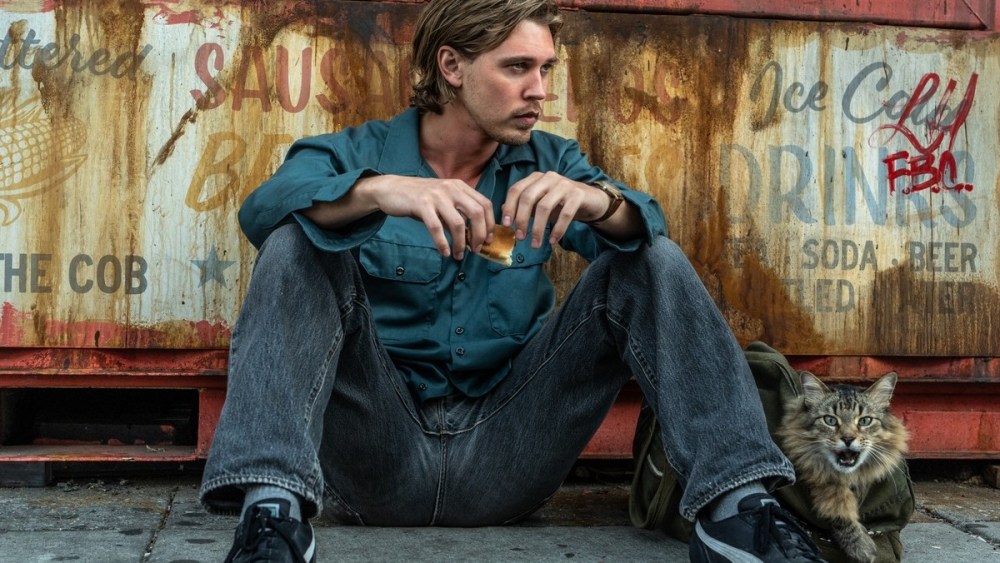There are two key tests of what makes a movie star. The first is whether the actor in question can carry a movie. That’s something Austin Butler does with an easy, laid-back charm in “Caught Stealing,” such that none of the characters with whom he shares the screen could be accused of stealing it out from under him. And the second is whether they can open it, which we’ll learn soon enough, when director Darren Aronofsky’s scuzzy misfit of a movie — featuring Butler’s most relatable role yet, despite the degree of violence to which he’s exposed — hits theaters on Aug. 29.
A dramatic gear shift for Aronofsky, “Caught Stealing” stars Butler as Hank Thompson, a New York bartender who watches Giants games, knowing that he really should be out there on the field, pounding baseballs into the stands. He’s still got a hell of a swing, though his knee exploded in a drunk-driving accident 10 years earlier that’s still so fresh in his mind, it gives him nightmares (that’s a smart change from Charlie Huston’s novel, where the injury and the accident occur separately).
Huston adapted the book himself — the first of three featuring the Hank Thompson character — tailoring Hank’s personality slightly to suit Butler’s ambivalent-golden-boy energy. The character grew up in California, and it shows — or at least, anyone can tell he’s not from New York, because Hank actually sees the people around him, instead of brushing right past them, the way locals do. Hank not only acknowledges the wino sleeping outside his stoop, but takes a minute to give him money. He lives in a sketchy walk-up on the Lower East Side, where he’s polite to his neighbors … and even agrees to cat-sit for Russ (Matt Smith), the drug-peddling English punk with the foot-high orange Mohawk who lives next door.
That friendly attitude is either his fatal flaw or his saving grace, depending on how you look at it. When Russ skips town, a colorful assortment of criminal elements descends on his apartment looking for something — a key, it turns out, but even then, it’s anybody’s guess what it opens. The first couple goons to stop by (Nikita Kukushkin and Yuri Kolokolnikov, looking bald and belligerent) beat Hank up so badly, he awakens in the hospital a few days later missing a kidney. And the bad guys keep on coming, till it’s clear that Hank’s only choice is to help them out or wind up dead.
Like Hank, the movie shows an acute interest in other people, which explains why it has such a memorable ensemble — one that includes his feisty paramedic girlfriend Yvonne (Zoë Kravitz), a poker-faced police detective (Regina King), his seen-better-days biker boss Paul (Griffin Dunne), the aforementioned pair of Russian mobsters, two exceptionally violent Orthodox brothers (Liev Schreiber and Vincent D’Onofrio) and a wild-card Puerto Rican gangster (an eccentric cameo from Bad Bunny that feels like it might have been lifted from a Guy Ritchie movie).
Aronofsky isn’t as flashy a director as Ritchie — or at least, he chooses not to be here — though the unpredictable sequence of encounters between Hank and the various members of the criminal underworld surprises and amuses, à la “Lock, Stock and Two Smoking Barrels.” Meanwhile, Dunne’s presence is a dead giveaway as to the kind of movie Aronofsky had in his mind to make. The New York-based director channels Martin Scorsese’s “After Hours,” with longtime cinematographer Matthew Libatique matching that mix of bustle and grit.
“Caught Stealing” is spread out over slightly more time, as Hank tries to do whatever it takes to get Russ’ enemies off his back and prevent more innocent people from getting killed in the process. But he’s a normal guy, not some John Wick super-assassin just looking for quiet. Hank coulda been a contender, but now he’s drowning in self-pity, trying to drink away his regrets. Such details might have sounded like clichés in a lesser writer’s hands, but Huston weaves them in such that Hank’s crisis doesn’t telegraph the personal redemption that potentially awaits him.
Refreshingly enough, Hank’s not one to hold grudges. When he loses a kidney, he doesn’t go looking for payback. Instead, he’s smart enough to avoid the Russians next time they come calling. He’s especially attentive to Russ’ cat, Bud, an ornery Maine coon (played by Tonic, the same cat seen in “Pet Sematary”) who bites everyone but Hank — which says something about this guy’s underlying nature. How often do the protagonists in movies like this take time to call their mothers?
Hank is no killer, though the movie does treat his athletic ability as an asset. In a Chinatown chase scene, he eases below a truck’s tailgate like he was sliding into home, and later, he wields a baseball bat like a deadly weapon. Releasing the same month as Spike Lee’s “Highest 2 Lowest,” “Caught Stealing” shows a similar appreciation for the city where it’s set, though Aronofsky’s film does more to accentuate the range of cultures and personalities to be found in New York. Over the course of several days, Hank travels to the far corners of the Big Apple, from Flushing Meadows, Queens (where Shea Stadium and the Unisphere feature prominently), to Coney Island and Brighton Beach in Brooklyn.
Whereas four of Aronofsky’s last five films premiered at the Venice Film Festival, this one opens in theaters the same weekend back home (sneak previewing widely to build word of mouth). “Caught Stealing” might feel like a break from the “Pi” director’s intensely subjective character portraits, which range from “The Wrestler” to “The Whale,” but in fact, Aronofsky brings us as close to Hank as he has to any of his other characters. For Butler, it’s not as flashy a role as the ones he played in “Elvis” or “Dune,” and yet, seeing the actor stripped down to his heather gray undies, his stardom is all but undeniable.

